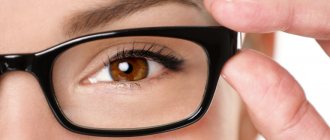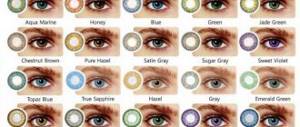Farsightedness is more difficult to diagnose and correct than its opposite, myopia. This is explained by oppositely directed processes in the ciliary muscle. With farsightedness, constant tension of the ciliary muscle allows you to achieve the desired image only when looking into the distance (when this muscle should be relaxed), closer objects are not projected onto the retina even with strong muscle tension, which is why the eyes quickly get tired and vision gradually deteriorates. To compensate for this, the patient has to wear not just glasses, but a whole set for different distances.
Advantages and disadvantages of this method of treating farsightedness
Spectacle correction is the oldest and time-tested way to compensate for insufficiently sharp vision. Despite the fact that more modern methods have appeared - contact lenses, laser correction - glasses still retain their popularity.
Their main advantage is the absence of contraindications. They can be worn at any age (surgery is performed only after 25 years, when eye growth is complete), during the treatment of various eye diseases (the combination of lenses and eye drops is not always favorable). The glasses do not come into contact with the eyes, are not irritating and have no side effects. And, of course, they effectively compensate for vision defects in farsightedness and myopia. This material will tell you about zero glasses for image.
In childhood, especially for preschoolers and primary schoolchildren, glasses are the preferred option for vision correction. Surgery is contraindicated, and the lenses can cause severe irritation.
But this method also has its drawbacks. The main one is convenience. Glasses are easy to break or lose, and damage to glasses on the face can result in eye injury. In addition, they fog up in winter and in high humidity. Corrective glasses cannot be combined with either safety glasses or their sun protection counterparts. A specific disadvantage of this method of correction for farsightedness is that most often, several pairs are required, which need to be constantly changed. Glasses with complex lenses made from several components (multifocal or progressive) are much more expensive than regular ones. This article will tell you about anti-glare glasses for drivers.
Diopter gradation of lenses
For farsightedness, converging lenses are used, so-called. “plus”, since their optical power (diopters) is indicated by a number with a + sign. Lenses are selected individually depending on the severity of the disorder. They may not be the same on the right and left eyes. The severity of farsightedness is expressed in numbers; the mode of wearing lenses depends on this parameter.
Degrees of farsightedness:
- Weak (less than +3), glasses required for reading and computer work;
- Medium (+3-+6), you need a set for constant wearing, if necessary, a second set for work and reading;
- Heavy (more than +6), several sets - for constant wearing outdoors, indoors and for reading.
Multifocal glasses are corrective devices, the glasses of which consist of two halves (less often three) - these are several lenses of different optical powers that can replace a set of glasses. Progressive glasses change optical power smoothly; depending on the viewing angle, the desired degree of correction can be achieved.
What glasses do you wear for farsightedness?
In case of farsightedness, the convex lenses of glasses collect rays, helping them to reach the retina of the eye, and not behind it. The degree of refractive power of the lens corresponds to the degree of farsightedness and is expressed in diopters with a “+” sign.
Entrust the selection of glasses for farsightedness to the doctors of the Svetlana Bogacheva Ophthalmological Clinic. Here you can undergo a complete vision diagnostics for both children and adults, check the presence and degree of farsightedness, as well as the risks of its complications. Here, at the Clinic’s optics, you can order lenses of any complexity and design from European manufacturers. A large selection of branded eyeglass frames will allow you to choose comfortable and stylish glasses with which farsightedness will be comfortable for life.
Features of optics for hypermetropia
Glasses are always selected individually. This takes into account not only the optical power, but also the distance between the centers of the eyes, as well as the size of the head. Depending on age, the rules for selecting corrective products and the features of wearing them change. Read about anti-glare glasses for computers here.
For adults with presbyopia
The basic rules for selecting glasses for strabismus and other diseases, as a rule, apply specifically to adults. But it’s worth mentioning separately about age-related farsightedness - this is a characteristic pathology of older people, which occurs due to the fact that the lens loses its elasticity. Elderly patients rarely require constant wearing of glasses unless farsightedness is combined with other vision defects.
In old age, it is recommended to wear sunglasses or so-called outdoor glasses. chameleons (preferably light ones). This allows not only to correct vision, but also to reduce the risk of developing cataracts and presbyopia. If age-related presbyopia is combined with myopia (and this is a fairly common situation), multifocal glasses are recommended. They can be worn constantly or when necessary - for distance reading and for reading.
Farsightedness has two names. Hypermetropia is any change in vision that is associated with decreased near vision. Age-related farsightedness has a separate name – presbyopia.
For young patients who spend a lot of time driving, glasses with darkening lenses are also suitable. If they are intended to be worn constantly, it is important to pay attention to comfort - the frame should fit perfectly on the face, not move or slide. This link will tell you how to remove scratches from glasses.
For children for vision correction
Based on the causes of the disease, children's lenses are selected according to the same rules as adults. They can be made of glass or plastic. Plastic glasses are lighter and thinner (which is important for high hyperopia or large differences between the eyes), but they are easy to scratch. Glass is more durable, but it is not always comfortable to wear, and its damage is more dangerous.
We must not forget about the aesthetic component - the child will refuse to wear ugly corrective devices for fear that he will be teased.
We should also talk about the frame. It should be at the same time durable, light and the child likes the look. It will take time to teach your child how to handle glasses carefully, so you should avoid frames that bend easily. It is preferable to take dense plastic frames - they are quite light, resistant to stress and can withstand temperature changes.
As the baby grows, the proportions of his head and face change, so it becomes necessary to order new frames. Also, vision can improve or worsen with age, so annual check-ups with an ophthalmologist and selection of new lenses, if necessary, are mandatory. Parents need to ensure that their child wears glasses every time he reads or sits at the computer, even if farsightedness is mild. Find out what the disease is called when you can’t see well up close here.
Spectacle correction of myopia in children and adults
The power of refraction of light, that is, the optical power of the lens, is measured in diopters. One diopter is equal to 1 m of the focal length of the lens. It is at this distance that a clear image is normally obtained.
The number of diopters is the degree of curvature of the lens. The range of changes in the optical power of a healthy person’s eye is ~14 diopters. With age, this figure decreases. For distance vision, the diopters need to be reduced, so glasses for myopia have a minus. With hypermetrometic diopters, the curvature of the lens must be added, so glasses are taken with a plus.
When is it necessary to wear optical devices for myopia?
Wearing glasses becomes necessary for myopia of 1 D, but this does not need to be done all the time, only when necessary. People with severe myopia should wear glasses at all times.
If a person’s work involves viewing objects closer than 40 cm, glasses can be removed. Ideally, it is better to have several pairs: for regular use, for reading and writing. You need to have them with you and use them for a specific occasion.
Hereditary myopia
Hereditary myopia is the most common form. And so much so that when diagnosing a pathology, it is precisely this that is implied. It is also important that the degree of myopia is inherited. The first and second degrees are transmitted as an autosomal dominant trait. This means that the mutant gene is located in one of the autosomes (non-sex chromosomes) and is dominant. It will appear in all generations. High - due to an autosomal recessive trait.
Important! Myopia is not inherited, but only a predisposition to it.
If there is only one myopic parent in a family, the risk of the disease in children will be 50-100%. When both are myopic, the probability will be 75-100%, but the child may remain only a carrier of the gene, that is, the descendants will receive the gene, but the parent will not get sick. If both parents have an asymptomatic gene, 25% of their children will be myopic, moreover, to the 3rd degree.
Rules for selecting glasses that correct vision
The procedure for selecting glasses occurs in several stages. The first of these is the determination of visual acuity. For this purpose, a table with letters (for small children - drawings) of variable size and special frames with replaceable lenses are used. By inserting the necessary glasses, the doctor determines how severe the visual impairment is and at what degree of correction the patient will be comfortable. For farsightedness, several sets of lenses are determined - for distance, for work, for reading, for constant wear.
The second stage is measuring the distance between centers. This is necessary to correctly position the lenses in the frame - the center of the glass must coincide with the optical axis of the eye. A ruler is used for this, and during measurement it is important for the patient to look straight ahead and stand straight to avoid mistakes.
The third is the selection of frames. There are three criteria here: convenience, beauty and compliance with the stated goals. The patient chooses the frame based on personal preferences, but there are general points to consider:
- strength , especially if glasses are supposed to be worn constantly;
- size and shape of lenses – they can be made to almost any size, but it is important to take into account the individual parameters of the face to make it comfortable;
- material - most often glass, metal or plastic. Here you need to take into account the technical characteristics of the materials.
- beauty is also important - glasses become part of the image, so there is nothing wrong with choosing frames that you like. This applies not only to women's accessories - men also want to look stylish.
How to wear
There are several wearing modes for glasses for farsightedness:
- for reading;
- for distance;
- for constant wear;
- for work.
Eye glasses for reading and computer work
Each of them has its own characteristics. Reading glasses provide ideal near vision correction. They are worn when working with small objects (handicrafts, precision manipulations, working with a microscope), as well as for reading and working at the computer. There is no need to use them constantly - when looking into the distance, the effect of excessive correction is created. You can get used to them very quickly.
How to choose distance glasses
Distance glasses are necessary for people with a high degree of farsightedness, when vision is impaired at any distance. They have a weak degree of correction and are designed to relieve excess tension from the eyes. As a rule, patients are advised to wear them outdoors and wear stronger ones indoors. Small work and reading in corrective means for distance are unacceptable.
How to get used to wearing glasses all the time
Glasses for constant wear suggest the optimal degree of correction in a particular case. They are suitable for performing household tasks, moving around the street and indoors, but for small work they may not be enough. Their main purpose is to eliminate unnecessary strain on the eyes in everyday life.
Should I use it for work?
Glasses for work are selected based on the patient’s profession. They may coincide with those for reading, may occupy an intermediate position between “fixed” and “reading” glasses, or almost approach distance glasses - this depends solely on the characteristics of the patient’s workplace.
Glasses for farsightedness: is it worth wearing?
Should I wear glasses if I am farsighted? It is believed that farsightedness is when you can see well in the distance but poorly up close. And what happens in old age, when grandparents put on glasses to read a book to their grandson. And this is not at all true. Grandparents experience presbyopia, an age-related change in vision that begins to develop after the age of 40. But almost every person goes through farsightedness when they are born with it. And with true farsightedness, it is difficult to see not only near, but also in the distance. Therefore, to answer the frequently asked question “Is it worth wearing glasses if you are farsighted?” let’s figure out what it is.











